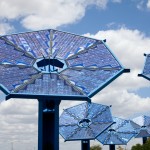Walmart Becomes A Solar King, Just Not in Texas. Yet.

Photo by David McNew/Getty Images
Solar panels cover the roof of a Sam's Club store that was one of Wal Mart's earlier solar installations in April 2009 in Glendora, California.
It’s where you might go for pool noodles, school supplies and perhaps just people-watching. But the retail behemoth Walmart is also becoming known as a green energy company.
On Monday, Walmart unveiled its 100th solar panel array for a store in San Diego. The company has the goal of using 100 percent renewable energy to power its stores, and the San Diego project is only the latest in a long line of solar initiatives at Walmart stores in California, expected to provide 10 to 30 percent of the retail outlets’ energy needs. And the company has solar arrays installed at stores in Arizona and Puerto Rico. Walmart’s green energy initiatives put it ahead of other like-minded companies like IKEA and Apple, according to BusinessWeek.
So, Texas has plenty of Walmarts. And plenty of sun. But there are no solar stores here. Why?
“We’re looking to expand the program,” says Brooke Buchanan, director of sustainability communications at Walmart. “And Texas is on the list for consideration.” The company aims to have 1,000 locations using solar power by 2020.
And while the company hasn’t put any solar panels on its Texas stores yet, it is utilizing our state’s wind.
The company purchases power from the Duke Energy wind farm in Notrees, Texas, west of Midland-Odessa. The goal is to get up to 15 percent of the power needed for over 350 Texas stores from the wind.
But doesn’t all of this renewable energy cost more? Not for Walmart. Much like it’s been able to use its hold on the retail market to negotiate with clients in order to offer low prices to consumers, the company’s size and scale have helped it install and purchase renewable energy at the price of traditional power.
“The more we get involved and commit to volume, the more the prices come down for the technology,” Marty Gilbert, director of energy at the Bentonville, Arkansas-based company, tells BusinessWeek. “Prices for solar panels, fuel cells, wind turbines to some degree, they are all approaching grid parity.”
Matthew Yglesias, in his business and economics blog at Slate, offers some analysis:
“There’s a tendency to sentimentalize the small in American life, but scale has some real advantages. A small firm is going to have enormous difficulty even studying the question of whether some unorthodox approach to energy makes sense. Instead decision-making will be driven by a mix of inertia and personal biases. And very large firms have the ability to make changes at large enough scales to overcome the inevitable transition costs that come from changing anything.”
You can read more about the Walmart’s green initiatives at the company’s website.

